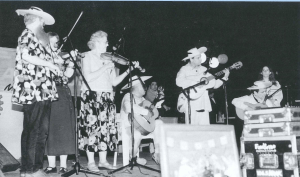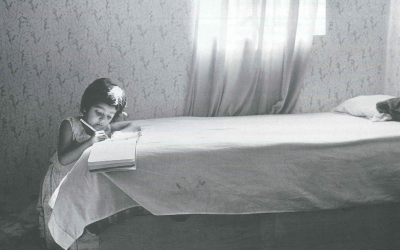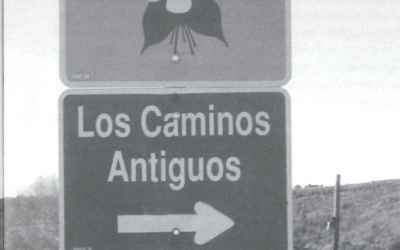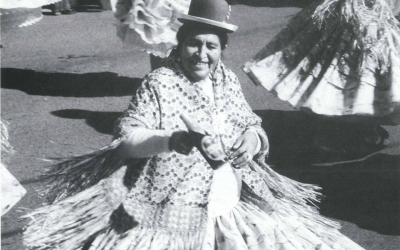Musical Tourism
A lively three-dollar cassette with a photo of an old Mexican fiddler on the cover inspired me several years ago to journey from my home in Mexico City to a little-known hotlands town in western Mexico to meet the musician. This casual weekend trip eventually led to the creation of an annual music festival Encuentro de Dos Tradiciones, a different way of doing tourism in Mexico.
While the festival seeks to showcase Juan Reynoso’s music and the local culture of Tierra Caliente, Guerrero, it represents an alternative for tourists who want to make friends with people from a different culture. The key that opens the door: sharing traditional music from Mexico and other countries. Because it is an exchange of musical traditions, the festival avoids “ob

Bayou Seco of New Mexico and the Grupo Huetamo of Michoacan share melodies on stage at a Dos Tradiciones concert. Photo by Lindajoy Fenley.
jectification” of the host culture; it’s conceived as a sharing rather than “observed” and “observer.” In addition to Calentana music from Tierra Caliente, Mexican styles that have been presented over the past five years include Son Arribeño (from the Sierra Gorda), Huapango (from the Huasteca) and Son Tixleco (from Tixtla, Guerrero). Visitors have brought Cajun, Appalachian, country blues, swing, Tex-Mex, Greek and Irish music from the United States and Cape Breton fiddling from Canada.
By being able to both play their own music and appreciate the music they come to learn about, these “alternative” tourists help create a dialogue that reminds me of a research technique an ethnomusicologist friend told me about. Henrietta Yurchenco of New York, who participated in the third Encuentro de Dos Tradiciones, says she uses “the back porch method” of informal conversation to get her informants to volunteer more details naturally.
The musicians and music fans find out much more about the people of Mexico than many other groups of tourists because of their willingness to share something of themselves. They get to know the people who sit next to them at the concerts, those that cook and serve special meals, the Mexican musicians and other folks they meet along the way. It’s a far cry from gawking at monuments or rushing from one city to another.
“We tell the truth with our violins,” said Louisiana musician Dirk Powell. “And between one or two beers, we forget the border,” he added in an impromptu poem he wrote during his second trip to Tierra Caliente in 1998.
Powell and his wife Christine Balfa of the Cajun band Balfa Toujours planted the seed for the Encuentro de Dos Tradiciones—the Encounter of Two Traditions—on July 3, 1996, when they and Reynoso performed at the same Festival of American Fiddle Tunes stage in Port Townsend, Washington. Dirk and Christine rushed up to meet Reynoso (now 89) and his two guitarist sons. Enthralled with the hauntingly beautiful Mexican music that was totally new to them, they decided to visit Mexico.
We looked forward to their visit and agreed it would be fun for them to share a stage in Mexico City. I decided to call the concert with the two groups the Encounter of Two Traditions. The following year the whole Balfa Toujours band came and the event expanded from a one-night venue in Mexico City to also include a weekend experience in Tierra Caliente with the Conjunto de Juan Reynoso and other local groups, the Brujos de Huejutla from Hidalgo, Yolotecuani from Tixtla, Guerrero, all representing Mexico; along with Balfa Toujours, the Fire Ants of Wyoming and several spontaneous groups from the United States.
The festival, now in its sixth year, features a Mexico City concert and dance workshops, followed by a trip to the Hotlands of Guerrero. The festival is having an impact on local culture, not by changing it but by encouraging preservation. We all agreed promoting Calentana music away from its roots wouldn’t help revive this dying art unless there we would also stage upbeat experiences to inspire younger members of the culture to play.
If we could travel in a time machine, we would see that Calentana and Cajun music have something besides fiddles in common. Calentana music is little known outside of the parts of Michoacán and Guerrero where it is played. Even there it lacks the full respect it deserves. Several decades ago, Louisiana’s Cajun music found itself in the same predicament. When Christine’s father and uncles were invited to the Newport Folk Festival in 1964, front-page editorials urged them to stay home, saying that up north they’d be laughed off the stage for their funky, down-home sound.
An audience of thousands rewarded the Balfa Brothers with thundering applause and Christine’s dad Dewey went on to promote Cajun music at home and abroad with pride. Cajun music is now known worldwide and attracts visitors to southwestern Louisiana whether or not there’s a festival on the calendar.
Calentana music still lacks such acclaim. However, it is increasingly recognized; Mexico’s president, Ernesto Zedillo, handed Juan Reynoso the National Award for Science and the Arts, the highest award an artist can receive in Mexico, in December 1997.
While the festival has inspired some musicians such as Paul Anastasio, a Seattle fiddler who started studying with Reynoso after the Dos Tradiciones festival began, to transcribe, record, and promote Calentana music, the yearly event also spurs cultural exchange among non-musicians.
Jim Blau, now a Brown University student, said that even though he doesn’t play music, he enjoyed the late-night jam sessions as well as the concerts.
“It’s a powerful thing to be invited into someone’s home and eat the food they eat,” says Marla Streator, a fiddler from Port Townsend, Washington who makes it a point not to miss our annual event that starts in Mexico City and ends in Ciudad Altamirano, Guerrero, each March. She treasures her friendships with Reynoso, other musicians and with a group of women who host a buffet breakfast at one of their homes our last morning in town each year. She also enjoys playing a role in breaking down stereotypes that divide people from different countries. “It’s a relief for them to know we’re not so judgmental,” she says, noting the cross-cultural exchange gives everyone a chance to see the others as plain folks.
The type of personal involvement musical tourism makes possible puts dancers and non-musicians as well as musicians in touch with people from different cultures, almost always on a harmonious note. For me, however, opening the area to tourists with a musical focus has hit both highs and lows. For example, getting local governments to pay some of the costs of putting on a free, international concert in a public plaza takes a good deal of my time and energy. Since the event has evolved into a series of three concerts in different towns each year, securing funding from three separate sources is an exercise I repeat again and again.
One year, the mayor of Tlalpehuala withdrew his previously enthusiastic invitation to our musical tourists just weeks before the event. The mayor of Cutzamala came to the rescue at the 11th hour by inviting the visitors to his plaza and hosting a generous fish feed just before the concert. But the city didn’t have funds to help offset our principal costs.
Following the election of a new mayor in Ciudad Altamirano, that city refused to support the festival because the prior administration, a strong supporter of our festival for two years, belonged to a different political party. But every cloud has its silver lining. When ordinary citizens learned municipal support had been pulled, they took up a collection. Fortunately, by the time we started counting on individual donations from Altamirano residents, the federal government had granted us the ability to issue tax-deductible donation receipts.
Altamirano remains a key venue because it offers the only adequate hotels for our group of 40 or more participants as well as being the commercial center of the region on the Guerrero side of the Balsas River. It also is the closest city to Reynoso’s home. We vary the other locations included in each tour since the cultural region called Tierra Caliente has 12 other municipalities to choose from in Guerrero, Michoacán and the state of Mexico.
In addition to municipal backing, support to pay for the headline musicians and other festival costs has come from the US-Mexico Fund for Culture (Rockefeller Foundation, Bancomer and the National Fund for Culture and the Arts), the United States and Canadian Embassies, and private companies such as airlines and hotels. Ed Littlefield, a Washington State musician and philanthropist, has provided major, ongoing funding.
The tourists—many of them accomplished musicians—also add economic resources. Their registration fees pay for their food, lodging and transportation and some of Dos Tradiciones’ administrative costs. Their participation is just as important as their money by helping to bridge the gap between cultures. They come to learn about Mexican music and culture and they share their own music and culture on and off stage.
Both the fiddler on the cassette I bought years ago and I believe our own encounter has changed our lives. Reynoso was living in near obscurity on a small amount of money he earned by playing in village bars and economic support from one of his sons is now an award-winning musician kept busy with performances and visitors. No longer a freelance journalist and foreign correspondent who happened to appreciate Mexican folk music, I now am the director of a non-profit organization that promotes traditional music from various countries who writes about music and culture rather than politics or economics.
The Dos Tradiciones trip into Tierra Caliente, five hours from my Mexico City home, has turned into a mission rather than a programmed adventure. Sharing the experience with others has taught me that musical tourism opens more than just ears. It opens hearts and minds to a culture on a basis of equality.
Winter 2002, Volume I, Number 2
Lindajoy Fenley enjoyed a 30-year career in journalism before founding Dos Tradiciones, a non-profit organization promoting traditional music and cultural exchange. She has produced three festival compact discs and an annual magazine since 1998. Dos Tradiciones’ web site (http://www.laneta.apc.org/DosTradiciones) offers more information about the festival which is open to traditional musicians and music fans from all countries.
Related Articles
Editor’s Letter: Tourism
Ellen Schneider’s description of Sandinista leader Daniel Ortega in her provocative article on Nicaraguan democracy sent me scurrying to my oversized scrapbooks of newspaper articles. I wanted to show her that rather than being perceived as a caudillo
Recreating Chican@ Enclaves
Centrally located between southern Colorado and northern New Mexico, is a hundred-mile long by seventy-mile wide intermountain basin known as the San Luis Valley. Surrounded on the east …
Tourist Photography’s Fictional Conquest
Recently, while walking across the Harvard campus, I was stopped by two tourists with a camera. They asked me if I would take a picture of them beside the words “HARVARD LAW SCHOOL,” …




